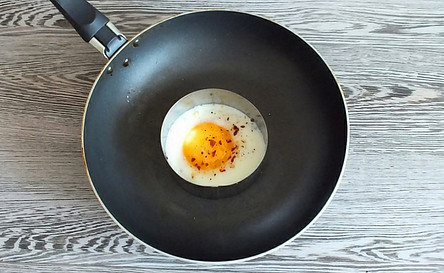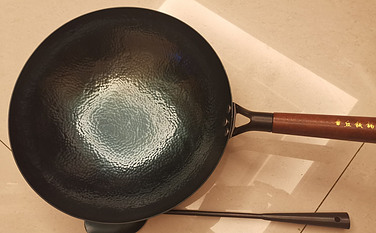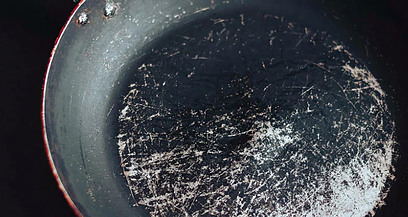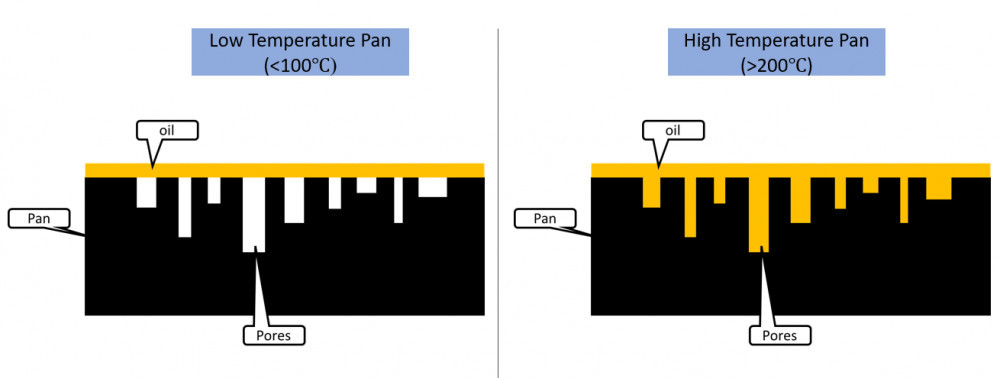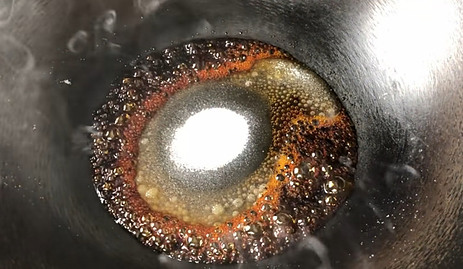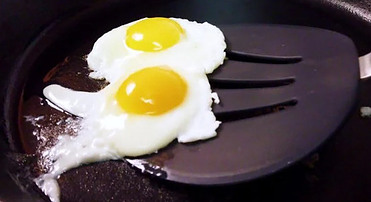Egg is a food enriched with a lot of nutrients, and a lot of people take it as part of their breakfast, lunch, or dinner.
Fried egg is a simple dish, but not easy to make as you may face the problem of eggs sticking to the pan.
Is not an easy job to clean a pan stick with egg, it would take a great effort to clean the pan.
Frying egg, a simple cooking method but there is a lot of knowledge behind it.
Some factors that contributed to egg sticking, it could be what kind of pans, heat temperature, and pan seasoning.
Here I am going to discuss why eggs stick to the pan and how to fry an egg without sticking. I hope this will solve your problem.
Table of Contents
Why do eggs stick to the pan no matter what?
Egg will stick to the pan when there is a chance the egg protein molecules contact with the pan’s metal atoms. How well the pan is seasoned determines whether the egg will stick or not. To fry an egg without sticking, when the pan is newly bought, season the pan for the first time as per instruction from manual. And each time before starting cooking, use the “spot seasoning” method to season the pan again to enhance the non-stick layer again.
Egg sticking, chemical bonding formed between pan metal atoms and egg protein molecules.
Before that let’s get a better understanding of why eggs stick to the pan in terms of molecular.
When protein is in contact with metal iron and applied with heat, chemical bonds are formed between protein molecules and iron atoms.
This is what we see, an egg sticking to an iron (cast iron, carbon steel, and stainless steel) pan.
The types of chemical that formed are relatively weak van der Waals forces or covalent bonds.
To prevent egg sticking to the pan, a layer of barrier needs to be created between the protein molecules and iron atoms.
There are factors that contribute to egg sticking to the pan, I will explain below and hope they are able to solve your egg sticking problem.
The pan is not well seasoned.
Pan seasoning is a process to bake a layer of oil polymers to the surface of the pan.
The layer of oil polymers becomes a non-stick layer which avoids the food molecules forming chemical bonds with the pan’s metal atoms.
The seasoning process is more applicable to cast iron and carbon steel pans, compared to stainless steel pans.
Cast iron and carbon steel pans are more resilient in maintaining the seasoning layer compared to stainless steel pans.
This is due to cast iron and carbon steel pans having a more porous surface compared to stainless steel pans, by microscopic level.
The pore size is in the order of cast iron, carbon steel, and stainless steel.
The oil is able to penetrate deeper into the big pores of the cast iron & carbon steel pans surface.
If you have egg sticking to cast iron or carbon steel pans, there is probably something wrong with the pan seasoning, or maybe the pans are not seasoned before.
A well seasoned cast iron or carbon steel shouldn’t have much issue with egg sticking when frying.
In the other way, stainless steel pans are not as porous as cast iron & carbon steel pans , the seasoning easily lost when cooked with acidic food (like tomato), used for boiling, and lost when cleaning.
Because of seasoning easily lost in stainless steel pan, more people are facing egg sticking problems with it.
Non-stick (Teflon) pan already damaged.
If you are facing an egg sticking problem with a non-stick pan, probably the pan is damaged.
A non-stick pan has a layer of non-stick coating on its surface, normally the Teflon is the material of the non-stick coating.
The Teflon coating could be damaged by overheating and it will break down and release toxic fumes into the air.
You will notice a damaged non-stick pan with changes of color on the pan surface.
Washing a heated high temperature with cold water will make the pan warped.
When a non-stick pan is warped, its surface would not be flat and the heat transfer to food will not be uniformed.
A damaged non-stick pan is no longer non-stick and causes egg sticking problems.
The pan temperature is not high enough.
Pan temperature not high enough can cause sticking. Why?
This is related to metal objects expanding when heated and shrinking when cold.
When the pan temperature is not high enough, the pores on the pan surface are small, the oil unable to penetrate into the pores.
If the egg drops into the low temperature pan, the egg will get the chance to contact the metal atom and form chemical bonding, thus the egg sticking to the pan.
But if the pan is heated with a high enough temperature (about 200 degree C), the pores size already expands and is big enough for the oil to penetrate deeply, the oil will easily fill up the pores, then a layer of oil coated on the pan surface, forming a barrier between the pan’s metal atoms and egg protein.
Your frying egg stick to the pan might be the pan not hot enough and the pores are not fully expanded.
When the oil is poured into the hot pan, the viscosity of the heated oil will drop, and become more easily penetrated into the pan surface pores.
The pan heat distribution is not even.
Heat source, no matter electrical stove or gas stove, both do not transfer the heat evenly to every point of the pan bottom.
Some points may be at high temperature and some points at low temperature at the pan.
If you are using an electric stove, you may notice the red glowing circle at it.
When you put the pan on an electric stove, the pan center temperature is lower than the outer circular area.
You can see the heat distribution by putting sugar on the pan surface and heating it, after that you would see the outer circular area sugar melt faster than the center.
So the uneven heat distribution can cause some of the pan area to have a low temperature and cause the egg to stick.
You flip the egg too early.
One of the mistakes people make when frying eggs is too early to flip the egg.
Wait for the egg edges to come with some crispy browning, then the pan will release the egg from sticking.
How to fry an egg without sticking.
For cast iron, carbon steel, and stainless steel pans:
a) Pre-heat the empty pan and monitor the pan temperature.
b) Make sure the heat is evenly distributed to the pan.
c) Add oil and heat until lightly smoking and change the heat to the lowest setting.
d) Crack the egg into the pan and don’t move the egg until it is ready.
e) Serve the egg.
a) Pre-heat the empty pan and monitor the pan temperature.
First, start with heating the empty pan, until it achieves about 200 deg C temperature, but how to measure the temperature?
There are a few methods.
The first method is using a temperature gun, the most straightforward.
If you don’t have a temperature gun, another method is to heat the pan until it is smoking, this method only applicable to cast iron and carbon steel pans, but not applicable to stainless steel pans.
It is because on the surface of cast iron & carbon steel pans, there is some oil residue which remains from cooking activities before.
The oil smoking point normally ranges between 200 to 250 degree C.
The smoking of the pan indicates it has already achieved more than 200 deg C temperature.
Pan smoking method is not suitable for stainless steel pan because its surface is clean and there is no oil residue left on the pan surface.
It doesn’t smoke even when heated until 300 deg C.
The last method is dripping water into the pan.
You can drip some water into the stainless steel pan to check the temperature, this method is based on the Leidenfrost effect.
The water dripping method is applicable to cast iron and carbon steel pans as well.
First, dripping some water into the pan, if the water evaporates quickly, the pan temperature is still not high enough.
Keep dripping water.
When the water becomes like pearls floating and moving on the pan, then the temperature is high enough for frying.
But be careful, when the water becomes floating pearls, it means the pan is at least 193 deg C, you won’t know the pan is 200 deg C or 300 deg C.
So if you use this method, the safe way is to keep dripping water into the pan, once the water becomes floating pearls, immediately change the heat setting to lowest or turn off.
b) Make sure the heat is evenly distributed to the pan
At the same time, make sure the stove distributes the heat evenly or not.
Adjust the location of the pan on the stove so that the lower temperature part can be increased.
Know your stove and pan, you should know which part of the pan normally has a low temperature and egg stick at which location.
c) Add oil and heat until lightly smoking and change the heat to the lowest setting.
Add the oil into the pan, just enough to cover the bottom of the pan.
Heat the oil until it is lightly smoking, this process may take about 2 to 3 minutes, but this subject to the types of pan you are using.
Once the light smoke is detected, set the heat to the lowest setting.
The smoking process should take about 30 seconds.
This process is to season the pan every time before you cook to avoid the food sticking in the pan.
When the oil is heated to a certain temperature, it will break and form polymers, which is a non-stick layer that is coated on the pan surface.
This is called “Spot seasoning method”, applicable to cast iron, carbon steel, and stainless steel pans.
d) Crack the egg into the pan and don’t move the egg until it is ready.
Then crack the egg into the pan.
Wait until the egg white turns into white color and the egg edges come with a little bit of crispy browning.
Try to use the spatula to move the egg and check if it can slide on the pan or not.
Then flip the egg to another side.
e) Serve the egg.
When the egg is completely fried, serve the egg.
For non-stick pan:
a) Make sure the non-stick pan is in good condition.
b) Add oil and heat with a low to medium temperature.
c) Crack the egg and wait until it is ready.
d) Try to move the egg (able to slide or not).
e) Serve the egg.
a) Make sure the non-stick pan is in good condition.
For a non-stick pan (Teflon), to fry an egg without sticking, first make sure the pan is in good condition.
Means not damaged by scratches, pan’s non-stick coating overheated, or the pan warped.
Make sure you don’t preheat it with an empty pan, Teflon non-stick coating will be damaged by heat with temperature above 500°F (260°C).
Damaged pan will cause egg sticking.
b) Add oil and heat with a low to medium temperature.
Put the oil into the pan, heat it at a low to medium temperature for about 2 to 3 minutes.
You may need to do an experiment by yourself to determine how long to heat the pan, as everyone has different types & sizes of pan and stove also different. If egg sticking, try to reduce the heating period, until you succeed in getting a fried egg without sticking.
The oil doesn’t need to be heated with a high temperature for frying eggs.
c) Crack the egg and wait until it is ready.
Then crack the egg into the pan.
Wait for the egg for about 4 to 5 minutes, for the egg white change color from clear to cloudy, and finally white color. Again the waiting time varies with the pan size & type, the stove. If the egg is taken out from the refrigerator, the waiting time may be even longer.
d) Try to move the egg (able to slide or not).
Try to use a spatula to move the egg and see whether it can slide on the pan.
e) Serve the egg.
You can serve the egg if it can be slide, for a sunny side up fried egg.
Final Thought
To avoid egg sticking in cast iron, carbon steel, and stainless steel pans, properly season them for the first time after buying. Each time before cooking, pre-heat the empty pan and heat the oil until lightly smoke to season the pan again.
To avoid egg sticking in a non-stick pan, make sure the pan is not damaged. Do not preheat the pan, start with oil in the pan and heat with a low to medium setting.
Make sure the heat distribution to the pan is even, this is important as well.
Do not move the egg until it is ready cooked and released from the pan surface (able to slide).
